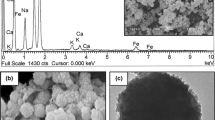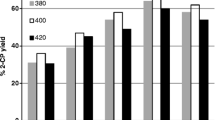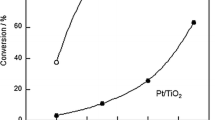Abstract
The self-inhibition behavior due to CO poisoning on Pt metal particles strongly impairs the performance of CO oxidation. It is an effective method to use reducible metal oxides for supporting Pt metal particles to avoid self-inhibition and to improve catalytic performance. In this work, we used in situ reductions of chloroplatinic acid on commercial Fe3O4 powder to prepare heterogeneousstructured Pt/Fe3O4 catalysts in the solution of ethylene glycol. The heterogeneous Pt/Fe3O4 catalysts achieved a better catalytic performance of CO oxidation compared with the Fe3O4 powder. The temperatures of 50% and 90% CO conversion were achieved above 260°C and 290°C at Pt/Fe3O4, respectively. However, they are accomplished on Fe3O4 at temperatures higher than 310°C. XRD, XPS, and H2-TPR results confirmed that the metallic Pt atoms have a strong synergistic interaction with the Fe3O4 supports. TGA results and transient DRIFTS results proved that the Pt metal particles facilitate the release of lattice oxygen and the formation of oxygen vacancies on Fe3O4. The combined results of O2-TPD and DRIFTS indicated that the activation step of oxygen molecules at surface oxygen vacancies could potentially be the rate-determining step of the catalytic CO oxidation at Pt/ Fe3O4 catalysts. The reaction pathway involves a Pt-assisted Mars-van Krevelen (MvK) mechanism.

Similar content being viewed by others
References
Allian A D, Takanabe K, Fujdala K L, Hao X, Truex T J, Cai J, Buda C, Neurock M, Iglesia E (2011). Chemisorption of CO and mechanism of CO oxidation on supported platinum nanoclusters. Journal of the American Chemical Society, 133(12): 4498–4517
Anderson R M, Zhang L, Loussaert J A, Frenkel A I, Henkelman G, Crooks R M (2013). An experimental and theoretical investigation of the inversion of Pd@Pt Core@Shell dendrimer-encapsulated nanoparticles. ACS Nano, 7(10): 9345–9353
Ayyappan S, Gnanaprakash G, Panneerselvam G, Antony M, Philip J (2008). Effect of surfactant monolayer on reduction of Fe3O4 nanoparticles under vacuum. Journal of Physical Chemistry C, 112(47): 18376–18383
Bazin P, Saur O, Lavalley J, Daturi M, Blanchard G (2005). FT-IR study of CO adsorption on Pt/CeO2: Characterisation and structural rearrangement of small Pt particles. Physical Chemistry Chemical Physics, 7(1): 187–194
Beccat P, Bertolini J, Gauthier Y, Massardier J, Ruiz P (1990). Crotonaldehyde and methylcrotonaldehyde hydrogenation over Pt (111) and Pt80Fe20 (111) single crystals. Journal of Catalysis, 126(2): 451–456
Benvenutti E V, Franken L, Moro C C, Davanzo C U (1999). FTIR study of hydrogen and carbon monoxide adsorption on Pt/TiO2, Pt/ZrO2, and Pt/Al2O3. Langmuir, 15(23): 8140–8146
Bera P, Gayen A, Hegde M S, Lalla N P, Spadaro L, Frusteri F, Arena F (2003). Promoting effect of CeO2 in combustion synthesized Pt/CeO2 catalyst for CO oxidation. Journal of Physical Chemistry B, 107(25): 6122–6130
Chavadej S, Saktrakool K, Rangsunvigit P, Lobban L L, Sreethawong T (2007). Oxidation of ethylene by a multistage corona discharge system in the absence and presence of Pt/TiO2. Chemical Engineering Journal, 132(1–3): 345–353
Chen S, Si R, Taylor E, Janzen J, Chen J (2012). Synthesis of Pd/Fe3O4 hybrid nanocatalysts with controllable interface and enhanced catalytic activities for CO oxidation. Journal of Physical Chemistry C, 116(23): 12969–12976
Costa R C, Moura F C, Ardisson J, Fabris J, Lago R (2008). Highly active heterogeneous Fenton-like systems based on FeO/Fe3O4 composites prepared by controlled reduction of iron oxides. Applied Catalysis B: Environmental, 83(1–2): 131–139
Fu Q, Li W X, Yao Y, Liu H, Su H Y, Ma D, Gu X K, Chen L, Wang Z, Zhang H, Wang B, Bao X (2010). Interface-confined ferrous centers for catalytic oxidation. Science, 328(5982): 1141–1144
Fu Q, Saltsburg H, Flytzani-Stephanopoulos M (2003). Active nonmetallic Au and Pt species on ceria-based water-gas shift catalysts. Science, 301(5635): 935–938
Hadjiivanov K I, Vayssilov G N (2002). Characterization of oxide surfaces and zeolites by carbon monoxide as an IR probe molecule. Advances in Catalysis, 47: 328
Ivanova A, Slavinskaya E, Gulyaev R, Zaikovskii V, Stonkus O, Danilova I, Plyasova L, Polukhina I, Boronin A (2010). Metal–support interactions in Pt/Al2O3 and Pd/Al2O3 catalysts for CO oxidation. Applied Catalysis B: Environmental, 97(1–2): 57–71
Jian W, Wang S P, Zhang H X, Bai F Q (2019). Disentangling the role of oxygen vacancies on the surface of Fe3O4 and g-Fe2O3. Inorganic Chemistry Frontiers, 6(10): 2660–2666
Li H, Jiao X, Li L, Zhao N, Xiao F, Wei W, Sun Y, Zhang B (2015). Synthesis of glycerol carbonate by direct carbonylation of glycerol with CO2 over solid catalysts derived from Zn/Al/La and Zn/Al/La/M (M = Li, Mg and Zr) hydrotalcites. Catalysis Science & Technology, 5(2): 989–1005
Liotta L, Di Carlo G, Pantaleo G, Venezia A (2010). Supported gold catalysts for CO oxidation and preferential oxidation of CO in H2 stream: Support effect. Catalysis Today, 158(1–2): 56–62
Liu W, Flytzani-Stephanopoulos M (1995). Total oxidation of carbon monoxide and methane over transition metal fluorite oxide composite catalysts: I. Catalyst composition and activity. Journal of Catalysis, 153(2): 304–316
ai]Liu X, Korotkikh O, Farrauto R (2002). Selective catalytic oxidation of CO in H2: Structural study of Fe oxide-promoted Pt/alumina catalyst. Applied Catalysis A, General, 226(1–2): 293–303
Liu X, Zhou K, Wang L, Wang B, Li Y (2009). Oxygen vacancy clusters promoting reducibility and activity of ceria nanorods. Journal of the American Chemical Society, 131(9): 3140–3141
Liu Z P, Gong X Q, Kohanoff J, Sanchez C, Hu P (2003). Catalytic role of metal oxides in gold-based catalysts: A first principles study of CO oxidation on TiO2 supported Au. Physical Review Letters, 91(26): 266102
Loh K S, Lee Y H, Musa A, Salmah A A, Zamri I (2008). Use of Fe3O4 nanoparticles for enhancement of biosensor response to the herbicide 2,4-dichlorophenoxyacetic acid. Sensors (Basel), 8(9): 5775–5791
Newton M A, Ferri D, Smolentsev G, Marchionni V, Nachtegaal M (2015). Room-temperature carbon monoxide oxidation by oxygen over Pt/Al2O3 mediated by reactive platinum carbonates. Nature Communications, 6(1): 8675–8681
Oliveira L, Fabris J, Rios R, Mussel WDN, Lago R (2004). Fe3-xMnxO4 catalysts: Phase transformations and carbon monoxide oxidation. Applied Catalysis A, General, 259(2): 253–259
Olsson L, Fridell E (2002). The influence of Pt oxide formation and Pt dispersion on the reactions NO2 ↔ NO + 1/2O2 over Pt/Al2O3 and Pt/BaO/Al2O3. Journal of Catalysis, 210(2): 340–353 doi:10.1006/jcat.2002.3698
Passos F B, De Oliveira E R, Mattos L V, Noronha F B (2005). Partial oxidation of methane to synthesis gas on Pt/CexZr1–xO2 catalysts: the effect of the support reducibility and of the metal dispersion on the stability of the catalysts. Catalysis Today, 101(1): 23–30
Qiao B, Wang A, Yang X, Allard L F, Jiang Z, Cui Y, Liu J, Li J, Zhang T (2011). Single-atom catalysis of CO oxidation using Pt1/FeOx. Nature Chemistry, 3(8): 634–641
Ruiz Puigdollers A, Schlexer P, Tosoni S, Pacchioni G (2017). Increasing oxide reducibility: The role of metal/oxide interfaces in the formation of oxygen vacancies. ACS Catalysis, 7(10): 6493–6513
Salomonsson P, Griffin T, Kasemo B (1993). Oxygen desorption and oxidation-reduction kinetics with methane and carbon monoxide over perovskite type metal oxide catalysts. Applied Catalysis A, General, 104(2): 175–197
Scirè S, Minicò S, Crisafulli C, Satriano C, Pistone A (2003). Catalytic combustion of volatile organic compounds on gold/cerium oxide catalysts. Applied Catalysis B: Environmental, 40(1): 43–49
Shou M, Tanaka K I, Yoshioka K, Moro-Oka Y, Nagano S (2004). New catalyst for selective oxidation of CO in excess H2 designing of the active catalyst having different optimum temperature. Catalysis Today, 90(3–4): 255–261
Tanaka K I, Shou M, He H, Shi X (2006). Significant enhancement of the oxidation of CO by H2 and/or H2O on a FeOx/Pt/TiO2 catalyst. Catalysis Letters, 110(3–4): 185–190
Wang C, Liu S, Wang D, Chen Q (2018). Interface engineering of Ru–Co3O4 nanocomposites for enhancing CO oxidation. Journal of Materials Chemistry. A, Materials for Energy and Sustainability, 6(23): 11037–11043
Wang C, Wang D, Yang Y, Li R, Chen C, Chen Q (2016). Enhanced CO oxidation on CeO2/Co3O4 nanojunctions derived from annealing of metal organic frameworks. Nanoscale, 8(47): 19761–19768
Yang S, Kim J, Tak Y J, Soon A, Lee H (2016). Single-atom catalyst of platinum supported on titanium nitride for selective electrochemical reactions. Angewandte Chemie International Edition, 55(6): 2058–2062
Yao Y F Y (1984). The oxidation of CO and hydrocarbons over noble metal catalysts. Journal of Catalysis, 87(1): 152–162
Yin H, Wang C, Zhu H, Overbury S H, Sun S, Dai S (2008). Colloidal deposition synthesis of supported gold nanocatalysts based on Au–Fe3O4 dumbbell nanoparticles. Chemical Communications, 36: 4357–4359
Zhang C, Liu F, Zhai Y, Ariga H, Yi N, Liu Y, Asakura K, Flytzani-Stephanopoulos M, He H (2012). Alkali-metal-promoted Pt/TiO2 opens a more efficient pathway to formaldehyde oxidation at ambient temperatures. Angewandte Chemie International Edition, 51(38): 9628–9632
Acknowledgements
We appreciate Ms. Christina Susan Gong for the assistance in proofreading. This work was financially supported by the National Key Research and Development Program of China (Nos. 2017YFC021100 and 2017YFC0210701), National Natural Science Foundation of China (Grant No. 21936005), and National Engineering Laboratory for Mobile Source Emission Control Technology (No. NELMS2018A12).
Author information
Authors and Affiliations
Corresponding author
Additional information
Highlights
• Strong metal-support interaction exists on Pt/Fe3O4 catalysts.
• Pt metal particles facilitate the formation of oxygen vacancies on Fe3O4.
• Fe3O4 supports enhance the strength of CO adsorption on Pt metals.
Electronic Supplementary Material
Rights and permissions
About this article
Cite this article
Li, Z., Geng, Y., Ma, L. et al. Catalytic oxidation of CO over Pt/Fe3O4 catalysts: Tuning O2 activation and CO adsorption. Front. Environ. Sci. Eng. 14, 65 (2020). https://doi.org/10.1007/s11783-020-1244-y
Received:
Revised:
Accepted:
Published:
DOI: https://doi.org/10.1007/s11783-020-1244-y




